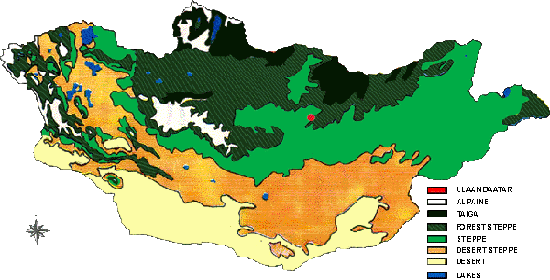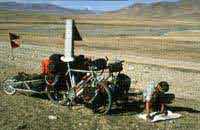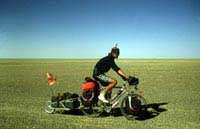Mongolia Information
Detailed topographic maps |
 |
There are three
kinds of maps available. Contact
us if you are interested in any of the maps listed below.
We are welcome to send you what you need for your trip. Topographic maps ordering information
|
Something about border crossings |
 |
Here is our latest information about various
border crossings in Mongolia. There seem to be promising efforts to
open up new ones at Lake Hovsgul, in the Altai mountains, or in east
Mongolia. |
If you plan to use any of the less frequented border crossings, it is highly recommeded to contact Mongolian and Russian or Chinese authorities prior to the trip. |
GPS-way points of intersections and wells |
During our tour we took a series of 50 GPS-way points, especially at unmarked intersections and turnoffs, as well as for streams, small lakes and wells. In addition we have quite a collection of other GPS points throughout the country. Contact us for more information. A list of GPS way points is also available at GPS-Navigation Mongolei.
Information about visa formalities |
Visa information:
General
Info about Mongolian Visa including addresses of embassies
Einreisebestimmungen
Mongolei (in German, a page at Monglolei
Online)
You should check out the Mongolei Online (it's in German, but has a lot of English links). It contains regularly updated information about visa formalities and a whole lot of other interesting facts about Mongolia.
Some hints on what to bring (especially for bikers and trekkers) |
- Mountainbike: we recommend steel frame bikes with steel racks. It is more important to have top quality that does not break on the way. There are no bike stores out there! Also bring enough patches and glue for fixing punctures - you will not be able to buy any in Mongolia. As spare parts we carried a tire, two inner tubes, some chain-parts and a rear derailleur. Also, bring all the tools you might need. Locals don't have special bike tools. Try to be prepared for the unexpected - we had to repair two broken front racks, and had to mend a tire with string and fix an inner tube with tape. A suspension fork will make riding more comfortable, but then it is important that you have a front rack that is comaptible with the suspension fork (we used one from Faiv). A trailer may be useful if you are planning tours away from the main towns and main tracks. The Rohloff Speedhub is actually the ideal gearing system for a remote place like Mongolia, since it allows immediate gear shifting in all situations, and is essentially maintenance free.
- Clothing: It can get cold in Mongolia - especially in spring and fall. However, since the climate in Mongolia is very continental, nights are cold, whereas during the day it gets rather hot.We carried thick fleece clothing and polypropylene underwear, as well as shorts for warm weather. If you travel later in the year (August to October) the chances of rain are very low. However, a GoreTex Jacket also serves as good protection against wind.
- Camping gear: if you plan on camping we recommend a tent that is stable in storms. We had several days with strong winds at night. A warm sleeping bag (up to -20°C) is recommended for everyone traveling in September and October. We often had frost at night! Your stove should work with regular fuel - white gas and camping gas is not readily available.
- Other stuff: bring enough batteries - they are hard to get. A GPS-device is useful, but not essential. For all those traveling on their own, a compass and maybe an altimeter are very useful for navigation. Mongolia is a high-altitude country, so UV protection for eyes and skin is essential.
Something about food |
| First of all: You
can buy food in Mongolia - the question is what kind of food... Supermarkets (or at least the Mongolian type) usually have stock foods like rice, western and local noodles, bread, sugar, flour. The stores in large cities like Ulaan Baatar are rather well stocked, you can get almost everything - if you search hard enough. In smaller towns the situation is very variable. If you happen to be in town when there is market, your chances of finding what you need are pretty good. On the markets you can even get vegetables (especially cabbage and tomatos), different kinds of breads, and fresh meat in addition to stock foods. |
 some of our food we took along |
If there's no market, you have to
search for the supermarket, which sometimes can be an adventure. You
may have to go to different stores, before you eventually find what
you need. In one town we spent exactly two hours finding 500 g of
noodles (we did not even care if they were western style or local).
As cyling tourist you need a lot of food and calories, and don't want to spend days finding your food. Also you need food in a good calories to volume ratio. Therefore, we brought all the food for seven weeks with us. This meant an additional 90kg of weight to carry. This weight was distributed among the two bikes and into the one BOB-Yak trailer we used. The additional weight was no big problem. |
|
Moreover, we were glad to be absolutely independent
of the situation of foo supply in towns, and we had excellent food
we designed especially for this tour. We have a list available about the kind of food we prepare. Check it out to be inspired for your own "expedition food". Our diet consisted of self mixed cereal, milk powder, self made pemmican, self made energy bars, power bars, self made marzipan, dried fruit, a self made trail-mix of nuts, sugar, noodles, rice, potato powder, sauce powder, spices (hard to find in Mongolia!), pudding powder, soybean oil, teabags. We ate about 4000 kcal, which was equivalent to a weight of 800 g of food per person per day. On the bikes we had capacities of carrying 30 L of water in three collapsible containers. |

a Mongolian grocery store |
Actually, you often will be invited
by Mongolians. They are very friendly and will always offer some of
their drinks and food to you: Fermented horse milk (airag); a high
percentage alcoholic beverage distilled from fermented horse milk
(archi); tea with yak milk; dried yoghurt (hard as stone and tastes
like one); dried cheese; raw butter; sometimes bread; often mutton
meat cooked in fat. Often the meat is served with cooked potatoes
or noodles. Spices and salt are not used a lot. Note that Mongolia is the country with highest risk of Brucellosis, which you get from consumption of raw milk products! |
|
Mongolia vegetation map |

Books
Topics
Topographic maps
Border crossings
Waypoints
Visa formalities
What to bring
Food
Vegetation
Report
![]() : Reisebericht der zweimonatigen
Radtour rund durch die Mongolei als pdf. Weiter...
: Reisebericht der zweimonatigen
Radtour rund durch die Mongolei als pdf. Weiter...
![]()
![]() :
Download the travel report about the two months long bike tour around Mongolia
as pdf. More...
:
Download the travel report about the two months long bike tour around Mongolia
as pdf. More...



